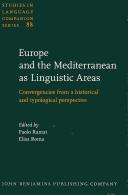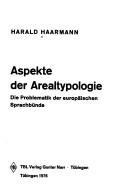| Listing 1 - 10 of 32 | << page >> |
Sort by
|
Periodical
ISSN: 26508176 Publisher: Grenoble : Université Stendhal-Grenoble 3, Centre de Dialectologie
Abstract | Keywords | Export | Availability | Bookmark
 Loading...
Loading...Choose an application
- Reference Manager
- EndNote
- RefWorks (Direct export to RefWorks)
Unique en France dans son domaine d’étude, Géolinguistique propose depuis 1984 l’actualité de la recherche sur la variabilité linguistique dans l’espace et sur la langue dans tous ses aspects, à travers le monde et sans négliger dialectes et langues à tradition orale. La revue est éditée chaque année par UGA Editions. Elle est répertoriée sur la liste ERIH PLUS : Nouvel index européen de référence pour les revues en sciences humaines et sociales.
Areal linguistics --- Area linguistics --- Geolinguistics --- Linguistics
Book
ISBN: 1282152033 9786612152030 9027291365 9789027291363 9027231001 9789027231000 9781282152038 9789027231000 Year: 2008 Publisher: Amsterdam Philadelphia John Benjamins Pub. Co.
Abstract | Keywords | Export | Availability | Bookmark
 Loading...
Loading...Choose an application
- Reference Manager
- EndNote
- RefWorks (Direct export to RefWorks)
This paper deals with an areal feature shared by languages spoken in Indo-China and Southern China, namely, the presence of a modal element in a for these languages a-typical post-verbal position. In this paper we investigate the properties of this element in Cantonese, Lao, Vietnamese and Zhuang. One of the questions we focus on is the fact that the element in question can be translated with 'can', but the languages differ in that only in a subset of them, it can mean 'can-ability'. It turns out that the interpretational properties of the element is tightly interrelated with both syntactic and interpretational properties of the resultative construction.
Areal linguistics. --- Area linguistics --- Geolinguistics --- Linguistics
Book
ISBN: 9789027231000 Year: 2008 Volume: 90 Publisher: Amsterdam Benjamins
Abstract | Keywords | Export | Availability | Bookmark
 Loading...
Loading...Choose an application
- Reference Manager
- EndNote
- RefWorks (Direct export to RefWorks)
Dialectology --- Areal linguistics. --- 800.87 --- Area linguistics --- Geolinguistics --- Linguistics --- Dialecten --- 800.87 Dialecten --- Areal linguistics

ISBN: 1134396317 1280280239 9786610280230 0203327713 9780203327715 0415308046 9780415308045 9781134396313 9781280280238 6610280231 9781134396269 9781134396306 9781138979871 1138979872 1134396309 Year: 2005 Publisher: London New York RoutledgeCurzon
Abstract | Keywords | Export | Availability | Bookmark
 Loading...
Loading...Choose an application
- Reference Manager
- EndNote
- RefWorks (Direct export to RefWorks)
The authors are outstanding scholars engaged in the study of language varieties spoken in 'convergence areas' in which speakers are multilingual in languages of at least two but sometimes all three language families. Many of the contributions present new data collected in fieldwork. The geographic area covered is Western and Central Asia where varieties of Iranian, Semitic and Turkic languages have entered into many different types of contact. The intricate linguistic contact situations demonstrate highly interesting convergence phenomena.
Languages in contact --- Areal linguistics. --- Area linguistics --- Geolinguistics --- Linguistics --- Areal linguistics
Multi
ISBN: 9781107051614 1107051614 9781107279872 9781107690035 110769003X 1316840018 1316839036 1107279879 Year: 2017 Publisher: Cambridge Cambridge University Press
Abstract | Keywords | Export | Availability | Bookmark
 Loading...
Loading...Choose an application
- Reference Manager
- EndNote
- RefWorks (Direct export to RefWorks)
Providing a contemporary and comprehensive look at the topical area of areal linguistics, this book looks systematically at different regions of the world whilst presenting a focussed and informed overview of the theory behind research into areal linguistics and language contact. The topicality of areal linguistics is thoroughly documented by a wealth of case studies from all major regions of the world and, with chapters from scholars with a broad spectrum of language expertise, it offers insights into the mechanisms of external language change. With no book currently like this on the market, The Cambridge Handbook of Areal Linguistics will be welcomed by students and scholars working on the history of language families, documentation and classification, and will help readers to understand the key area of areal linguistics within a broader linguistic context.
Dialectology --- Areal linguistics --- Linguistic geography --- Dialect geography --- Geography, Linguistic --- Language and languages --- Language geography --- Area linguistics --- Geolinguistics --- Linguistics --- Geography --- Géographie linguistique --- Géographie linguistique
Book

ISSN: 14343452 ISBN: 3110279428 9783110279429 9783110278842 3110278847 1299720390 Year: 2012 Volume: 80 Publisher: Berlin Boston
Abstract | Keywords | Export | Availability | Bookmark
 Loading...
Loading...Choose an application
- Reference Manager
- EndNote
- RefWorks (Direct export to RefWorks)
The intention of the present volume is to unite the research of a range of scholars who have been working on features of non-standard, vernacular English which show an areal distribution, i.e. which cluster geographically across the world. Features common to an area can be due to (i) shared dialect input, (ii) common but separate innovations after settlement, or (iii) area-internal diffusion from one variety to another and/or others. The relative weighting of these factors is an important topic in the book and is a key focus in the 17 chapters. The book is divided into two large blocks, the first one consisting of case studies (8 chapters) and the second with features complexes (9 chapters). The former look at major anglophone locations from an areal perspective while the latter examine linguistic categories and features with a view to determine whether these could be areally based or not.
Linguistic geography. --- Areal linguistics. --- Area linguistics --- Geolinguistics --- Linguistics --- Dialect geography --- Geography, Linguistic --- Language and languages --- Language geography --- Areal linguistics --- Dialectology --- Geography --- Dialectology. --- English.

ISBN: 1282152874 9786612152870 9027292221 9789027292223 9027230986 9789027230980 9789027230980 Year: 2007 Volume: 88 Publisher: Amsterdam Benjamins
Abstract | Keywords | Export | Availability | Bookmark
 Loading...
Loading...Choose an application
- Reference Manager
- EndNote
- RefWorks (Direct export to RefWorks)
This article provides a new vista of an old problem, viz. the supposed counter-iconic nature of a variety of reduplicative patterns which encode categories such as diminution, attenuation, etc. It is argued that even these categories are iconically represented by reduplication because iconicity is not tied to an increase in size of the entities referred to by the reduplicative construction. Iconicity applies if the semantic description of the quality encoded by reduplication is more complex than the one necessary for the description of the non-reduplicated pattern. This new understanding of iconicity is illustrated by examples of total reduplication drawn from a world-wide convenience sample of languages. Circum-Mediterranean languages are given special emphasis in the final discussion.
Areal linguistics. --- Area linguistics --- Geolinguistics --- Linguistics --- Europe --- Languages. --- Linguistique géographique --- Linguistique --- History --- Histoire --- Langues --- Grammar --- Sociolinguistics --- Areal linguistics --- Languages --- Europe - Languages --- Language and languages. --- Europe.
Book
ISBN: 9004281525 9789004281523 9789004281318 9004281312 Year: 2014 Publisher: Leiden Boston
Abstract | Keywords | Export | Availability | Bookmark
 Loading...
Loading...Choose an application
- Reference Manager
- EndNote
- RefWorks (Direct export to RefWorks)
Quantifying Language Dynamics: On the Cutting Edge of Areal and Phylogenetic Linguistics contains specially-selected papers introducing new, quantitative methodologies for understanding language interaction and evolution. It draws upon data from the phonologies, morphologies, numeral systems, constituent orders, case systems, and lexicons of the world’s languages, bringing large datasets and sophisticated statistical techniques to bear on fundamental questions such as: how to identify and account for areal distributions, when language contact leads to grammatical simplification, whether patterns of morphological borrowing can be predicted, how to deal with contact within phylogenetic models, and what new techniques are most effective for classification of the world’s languages. The book is relevant for students and scholars in general linguistics, typology, and historical and comparative linguistics.
Linguistics --- Linguistic analysis (Linguistics) --- Areal linguistics. --- Area linguistics --- Geolinguistics --- Analysis, Linguistic (Linguistics) --- Analysis (Philosophy) --- Grammar, Comparative and general --- Linguistic science --- Science of language --- Language and languages --- Research --- Methodology.

ISBN: 3878080727 9783878080725 Year: 1976 Volume: 72 Publisher: Tübingen Narr
Abstract | Keywords | Export | Availability | Bookmark
 Loading...
Loading...Choose an application
- Reference Manager
- EndNote
- RefWorks (Direct export to RefWorks)
Linguistics --- Europe --- Typology (Linguistics) --- Areal linguistics --- Languages --- Area linguistics --- Geolinguistics --- Grammar, Comparative and general --- Language and languages --- Linguistic typology --- Linguistic universals --- Typology --- Classification --- Languages. --- Areal linguistics. --- Typology (Linguistics). --- Europe - Languages
Book
ISBN: 2763770428 9782763770420 Year: 1984 Volume: A-19 A-19 Publisher: Quebec Presses de l'Université Laval
Abstract | Keywords | Export | Availability | Bookmark
 Loading...
Loading...Choose an application
- Reference Manager
- EndNote
- RefWorks (Direct export to RefWorks)
Language and languages --- Bilingualism --- Multilingualism --- Langage et langues --- Bilinguisme --- Multilinguisme --- Political aspects --- Aspect politique --- Areal linguistics --- Plurilingualism --- Polyglottism --- Languages in contact --- Area linguistics --- Geolinguistics --- Linguistics --- Areal linguistics. --- Bilingualism. --- Multilingualism.
| Listing 1 - 10 of 32 | << page >> |
Sort by
|

 Search
Search Feedback
Feedback About UniCat
About UniCat  Help
Help News
News